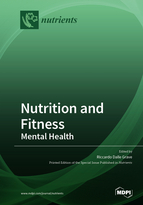Nutrition and Fitness: Mental Health
A special issue of Nutrients (ISSN 2072-6643). This special issue belongs to the section "Clinical Nutrition".
Deadline for manuscript submissions: closed (28 February 2020) | Viewed by 58282
Special Issue Editor
Interests: eating disorders; obesity; nutrition; cognitive behavior therapy; lifestyle modification; digital treatment; weight loss drugs
Special Issues, Collections and Topics in MDPI journals
Special Issue Information
Dear Colleagues,
Mens sana in corpore sano (a healthy mind in a healthy body) is a Latin phrase taken from Giovenale (Satire, X, 356) that remains relevant and is supported by today’s data regarding genetics and nutrition, and their contribution to mental health. The purpose of this Special Issue on “Nutrition and Fitness: Mental Health” is to provide an update on the latest evidence regarding the association between nutrition, physical activity (and inactivity) and physical fitness and the mental health of children, adolescents, and adults. Particularly, papers (reviews and clinical or experimental studies) dealing with the association between nutrition, physical fitness and mental health both in general and with regard to specific mental disorders, and nutrients and physical activity as agents for prevention, treatment, or augmentation of treatment for mental disorders, will be included.
Dr. Riccardo Dalle Grave
Guest Editor
Manuscript Submission Information
Manuscripts should be submitted online at www.mdpi.com by registering and logging in to this website. Once you are registered, click here to go to the submission form. Manuscripts can be submitted until the deadline. All submissions that pass pre-check are peer-reviewed. Accepted papers will be published continuously in the journal (as soon as accepted) and will be listed together on the special issue website. Research articles, review articles as well as short communications are invited. For planned papers, a title and short abstract (about 100 words) can be sent to the Editorial Office for announcement on this website.
Submitted manuscripts should not have been published previously, nor be under consideration for publication elsewhere (except conference proceedings papers). All manuscripts are thoroughly refereed through a single-blind peer-review process. A guide for authors and other relevant information for submission of manuscripts is available on the Instructions for Authors page. Nutrients is an international peer-reviewed open access semimonthly journal published by MDPI.
Please visit the Instructions for Authors page before submitting a manuscript. The Article Processing Charge (APC) for publication in this open access journal is 2900 CHF (Swiss Francs). Submitted papers should be well formatted and use good English. Authors may use MDPI's English editing service prior to publication or during author revisions.
Keywords
- mental health
- depression
- eating disorders
- obesity
- nutrition
- exercise
- inactivity
- physical fitness
- nutraceuticals
- prevention







